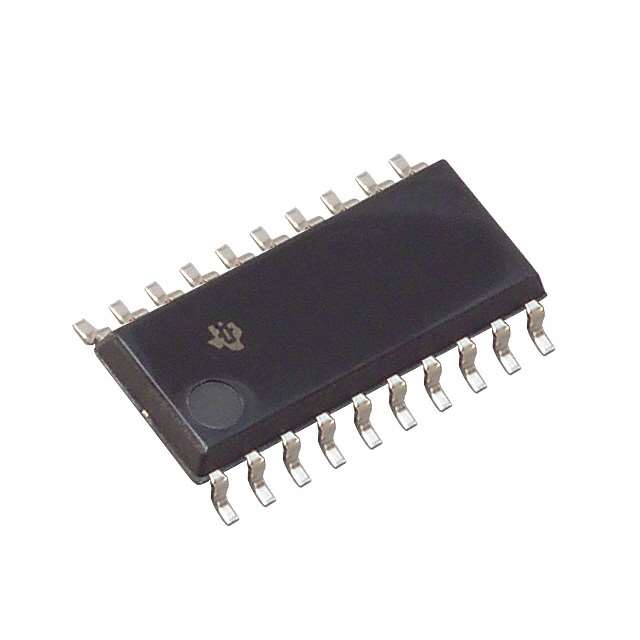SN74AHCT245NSR
Product Overview
- Category: Integrated Circuit
- Use: Level Shifter/Transceiver
- Characteristics: High-Speed, Non-Inverting, 8-Bit Bidirectional Transceiver
- Package: SOIC (Small Outline Integrated Circuit)
- Essence: Transfers data between two bidirectional bus systems
- Packaging/Quantity: Tape and Reel, 2500 pieces per reel
Specifications
- Supply Voltage Range: 4.5V to 5.5V
- Input Voltage Range: 0V to VCC
- Output Voltage Range: 0V to VCC
- High-Level Input Voltage: 2V to VCC + 0.5V
- Low-Level Input Voltage: -0.5V to 0.8V
- High-Level Output Voltage: VCC - 0.5V
- Low-Level Output Voltage: 0.5V
- Maximum Operating Frequency: 74 MHz
Detailed Pin Configuration
The SN74AHCT245NSR has a total of 20 pins. The pin configuration is as follows:
- OE (Output Enable) - Active low output enable input
- A1 - Data input/output for Port A
- B1 - Data input/output for Port B
- A2 - Data input/output for Port A
- B2 - Data input/output for Port B
- A3 - Data input/output for Port A
- B3 - Data input/output for Port B
- GND (Ground) - Ground reference
- B4 - Data input/output for Port B
- A4 - Data input/output for Port A
- B5 - Data input/output for Port B
- A5 - Data input/output for Port A
- B6 - Data input/output for Port B
- A6 - Data input/output for Port A
- B7 - Data input/output for Port B
- A7 - Data input/output for Port A
- VCC - Positive power supply
- DIR (Direction Control) - Direction control input
- B8 - Data input/output for Port B
- A8 - Data input/output for Port A
Functional Features
- Bidirectional data transfer between two independent bus systems
- Non-inverting logic levels
- High-speed operation
- 3-state outputs for bus isolation
- Output enable control for disabling the outputs
Advantages and Disadvantages
Advantages: - High-speed operation allows for efficient data transfer - Non-inverting logic levels simplify interfacing with different systems - 3-state outputs provide bus isolation when needed - Output enable control offers flexibility in enabling/disabling the outputs
Disadvantages: - Limited operating frequency compared to some other transceivers - Requires a specific supply voltage range (4.5V to 5.5V)
Working Principles
The SN74AHCT245NSR is designed to facilitate bidirectional data transfer between two independent bus systems. It operates by receiving data from one bus system and transmitting it to the other, while also allowing data flow in the opposite direction. The non-inverting logic levels ensure that the transmitted data retains its original polarity.
The direction of data flow is controlled by the DIR (Direction Control) pin. When DIR is set to a specific logic level, the data is transferred in the corresponding direction. The OE (Output Enable) pin can be used to disable the outputs, effectively isolating the bus systems.
Detailed Application Field Plans
The SN74AHCT245NSR is commonly used in various applications where bidirectional data transfer between different bus systems is required. Some of the typical application fields include:
- Microcontroller interfacing with external memory or peripherals
- Communication systems involving multiple bus protocols
- Data acquisition and control systems
- Industrial automation and control
- Automotive electronics
Detailed and Complete Alternative Models
- SN74AHCT245DWR: SOIC package, 2500 pieces per reel
- SN74AHCT245PW: TSSOP (Thin Shrink Small Outline Package), 2000 pieces per reel
- SN74AHCT245PWR: TSSOP package, 2000 pieces per reel
- SN74AHCT245QDRQ1: SOIC package, automotive-grade, 2500 pieces per reel
These alternative models offer similar functionality to the SN74AHCT245NSR but may differ in package type, quantity per reel, or automotive-grade specifications.
Word count: 511 words
Senaraikan 10 soalan dan jawapan biasa yang berkaitan dengan aplikasi SN74AHCT245NSR dalam penyelesaian teknikal
Sure! Here are 10 common questions and answers related to the application of SN74AHCT245NSR in technical solutions:
Q: What is SN74AHCT245NSR? A: SN74AHCT245NSR is a non-inverting octal bus transceiver with 3-state outputs, commonly used for level shifting and signal buffering in digital systems.
Q: What is the voltage range supported by SN74AHCT245NSR? A: SN74AHCT245NSR supports a voltage range of 4.5V to 5.5V, making it compatible with standard TTL and CMOS logic levels.
Q: How many bidirectional channels does SN74AHCT245NSR have? A: SN74AHCT245NSR has 8 bidirectional channels, allowing for parallel data transfer between two buses.
Q: Can SN74AHCT245NSR handle high-speed data transfer? A: Yes, SN74AHCT245NSR can handle high-speed data transfer up to 24 MHz, making it suitable for various applications.
Q: What is the maximum current that SN74AHCT245NSR can source or sink? A: SN74AHCT245NSR can source or sink up to 8 mA of current per channel, ensuring reliable signal transmission.
Q: Is SN74AHCT245NSR compatible with 5V and 3.3V logic systems? A: Yes, SN74AHCT245NSR is compatible with both 5V and 3.3V logic systems, making it versatile for different applications.
Q: Can SN74AHCT245NSR be used for level shifting between different voltage domains? A: Yes, SN74AHCT245NSR can be used for level shifting between different voltage domains, allowing communication between systems with different logic levels.
Q: Does SN74AHCT245NSR have built-in protection features? A: Yes, SN74AHCT245NSR has built-in ESD protection on all inputs and outputs, ensuring robustness against electrostatic discharge.
Q: Can SN74AHCT245NSR operate in a 3-state mode? A: Yes, SN74AHCT245NSR supports a 3-state output mode, allowing the bus to be disconnected from the system when not in use.
Q: What is the package type of SN74AHCT245NSR? A: SN74AHCT245NSR is available in a small-outline integrated circuit (SOIC) package, which is commonly used in electronic designs.
Please note that these answers are general and may vary depending on specific application requirements.


